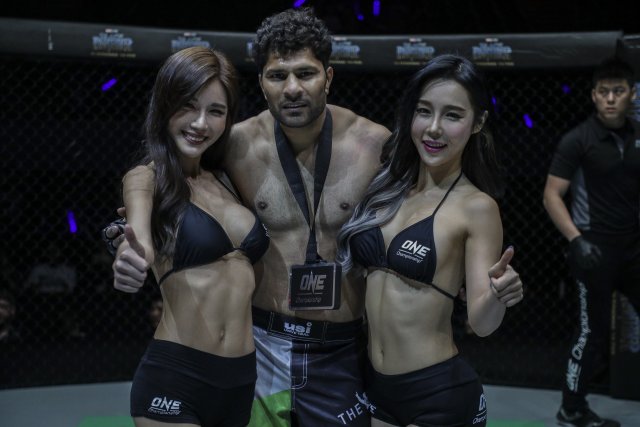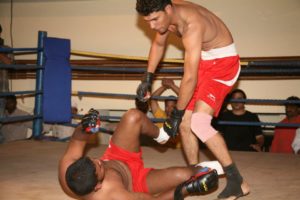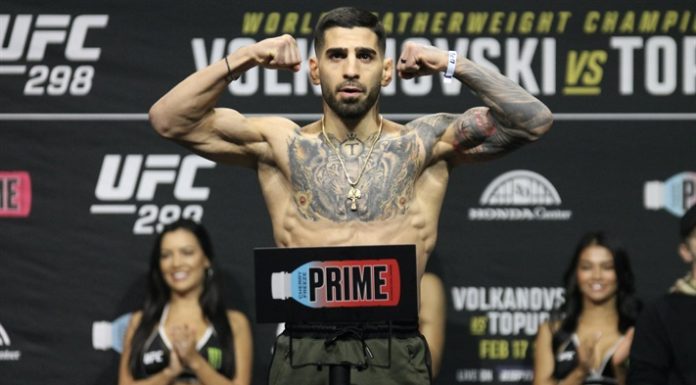
Part two of our dive into Indian MMA takes a look at the beginnings that built the foundation of the fractured state it is currently in.
In the last part, we learned about the condition of Indian MMA. It was made very clear that fighters in India have zero to negligible opportunities, fighter safety is pathetic, and the sport isn’t performing well commercially. To understand why this is the case, one needs to study the way the sport has evolved in India.
The sport of MMA in every country has evolved from the existing combat sports culture of that country. It must be noted that no single full-contact unarmed combat sport is responsible for the growth of MMA; it is the coming together of various kinds of martial artforms which leads to the creation of the MMA structure in any place. The martial artforms that come together usually don’t have Olympic representation and aren’t doing great business. In fact, most of the time, heads of sfcuch sports take a dive into the world of MMA just to get fame and to get their original sport popularity.
Since the inception of MMA, there have been unarmed combat sports which have gained prominence. A perfect example of a not-so-prominent-sport which gained popularity because of MMA is Brazilian Jiu-Jitsu (BJJ).
BJJ back in the early 1990s wasn’t as popular or recognized as it is today. It was because of the successful run of many BJJ grapplers, like Royce Gracie, in MMA that BJJ gained prominence across the globe. BJJ is now considered one of the basic martial arts one needs to know to survive in MMA.
Another sport which is gaining popularity because of its involvement in MMA is Sambo. Sambo was a sport which was confined within the former Soviet republics. However, since the rise of fighters like Khabib Nurmagomedov, Vitaly Minakov, Islam Makhachev and other Russian fighters, Sambo is gaining popularity in the martial arts world.
In India too, the sport of MMA began when a member of a kickboxing body decided to try his hand at MMA. His name was Daniel Isaac.
Daniel Isaac
Daniel Isaac was a kickboxer who had also trained in the art of Karate and Taekwondo. Isaac came from a family of martial artists, as his father and grandfather both were martial artists. “I was born into a martial arts family, If you are an Isaac you learn to fight – that’s just it! I was learning how to kick and punch while learning to walk,” said Isaac. “My foundation in the martial arts was in our family martial art of ‘Ishudo.’ To put it in simple terms, Ishudo is a traditional form of modern mixed martial arts. It consists of striking, grappling and ground fighting techniques. I was taught the fundamentals of MMA by my father, the late Grandmaster Solomon Isaac. He organized India’s first No-Holds-Barred [freestyle] fighting tournament in 1987 in Nasik, before UFC 1. I trained in Muay Thai from Master Sken.”
In the Indian MMA community, Isaac is regarded as a pioneer as he established his MMA gym, Tiger’s MMA, sometime in the early 2000s. Tiger’s MMA is the place where India’s first UFC fighter, Bharat Kandare learned what MMA was.
Clash of Champions
Clash of Champions was the first ever pro-MMA promotion based in India. The promotion was founded by Daniel Isaac back in 2004 and held its first event on February 29, 2004. The promotion held a total of six events, with the last being held on April 17, 2007.
The promotion invited not only Indian but also foreign fighters to compete in their events. Opening up about the idea behind the promotion, Isaac said, “I started Clash of Champions to help introduce MMA to India. Between 1998 and 2000, I used to take my students [led by my senior student Alan Fenandes] to wrestling akhadas (training school) where they would have friendly sparring bouts against local wrestlers. This inspired me to start these fights on a more serious level. During those days, I realized that even though Pride, K1, and UFC were being held in Japan and the US and being televised…the Indian audience knew nothing about this new phenomenon called MMA,” said Isaac. “During those days when my students would mix striking, takedowns, and submission techniques in their sparring bouts, the local wrestlers would ask if we were training in WWE techniques.”
In fact, the first Clash of Champions event became a big deal as it attracted a lot of attention. “When the first Clash of Champions was held in Nasik on February 29, 2004, The Mayor of Nasik, Dashrath Patil, attended as chief guest, and fighters from United Arab Emirates, Iran, Egypt, and India competed against each other. Veteran Indian fighters Alan Fenandes and Shafiq-Ur-Rehman fought international opponents at this event and won,” Daniel added. “Clash of Champions always featured a mixed fight card of grappling bouts/ pankration style bouts, kickboxing and MMA bouts. It was my way of helping the audience see the different fighting styles before accepting MMA.” Clash of Champions officially began mixed martial arts in India. Members of this promotion later became the founding members of MMA in India.
Alan Fenandes: Alan was the brightest student of Daniel Isaac. A former wrestler, Fenandes made his switch to MMA under Isaac and competed in a total of five fights. His record today stands as three wins to two losses. He later became a member of AIMMAA and today works as an executive there. He is also one of the referees of AIMMAA.
After the success of Clash of Champions, Isaac decided to take his promotion to the commercial capital of India, Mumbai.
Impact of Clash of Champions
It was the inception of Indian MMA
Clash of Champions was the beginning of MMA in India. These fights were added as records on Sherdog and were responsible for the introduction of the concept of MMA to the Indian combat sports community.
It created the first batch of Indian MMA fighters
As mentioned earlier, every prominent Clash of Champions fighter later went on to become the founding member of the Indian MMA community. Clash of Champions was the platform from where they not only learned about MMA but also showcased their talent. They managed to create the first batch of Indian MMA fighters. These fighters were the ones who passed down their knowledge to their students, who later turned out to become even more successful MMA fighters.
GYM WARS
Isaac alone couldn’t generate the finance required to set up an MMA promotion in Mumbai. That is when he decided to contact his close friend, Jitendra Khare, to help relocate the promotion. Khare came from a Judo background and was aware of the concept of MMA but wasn’t really a part of the MMA business. This invitation from Daniel is what got Khare in the world of MMA.
“Clash of Champions was being hosted with Indian fighters competing against International opponents but apart from the local gym sparring matches held in Nasik, there were no low-level bouts being held to help scout fighters and develop talent,” said Isaac. “In early 2009, Jitendra Khare reached out to me via email. We had been schoolmates in Barnes School, Devlali, where we were part of a Ninja training group and practiced martial arts in my backyard. Jitendra had also been training in martial arts under my dad Grandmaster Solomon Isaac during his school days. Then after much discussion and planning, Jitendra and his partner Sudipto invested their own money and launched Evolution MMA in Kandivali West, Mumbai, on December 2, 2009. Tigers Gym worked in association with Evolution MMA to introduce MMA training in Mumbai, and I brought a team of Tigers Gym fighters led by veteran Indian fighter Alan Fenandes to feature MMA and BJJ demonstrations at Evolution MMA between December 2 and 8. Alan started teaching BJJ, and I was teaching MMA striking techniques at Evolution MMA, Mumbai. We used to travel from Devlali to Mumbai every weekend to teach. We had a good relationship with the owners of Evolution.”
Now originally Gym Wars was a promotional tool used by Evolution MMA to increase its popularity. The concept of Gym Wars was to invite fighters from other gyms to compete against Evolution/Tigers Gym fighters. The fights would take place in Evolution’s gym. This was done to bring in more clients to the gym. “Even though membership was stable at Evolution MMA Mumbai, we [Jitendra, Sudipto, Alan and I] started discussing some radical new ways to attract members. I suggested that we invite fighters/trainers from other gyms in Mumbai to fight our guys, the strategy worked…soon fighters from different gyms in Mumbai started making their way to Kandivali, Mumbai, to compete against our fighters. This is how Gym Wars was born.”
Consequently, Gym Wars started gaining a lot of attention. This move brought in a major change. In the beginning, the Gym Wars fights were conducted in the most informal fashion possible. The fights took place in small closed rooms on mats, and fighters fought with pads on. They weren’t really MMA fights, but more like exhibition matches, meant to attract customers. However, as the events gained more popularity, the setup improved. “Soon Gym Wars became a platform for amateur fighters to test their skills in MMA. We used amateur MMA rules and provided sparring gear, doctors, first aid, and an ambulance for fighters. After a few events, we started attracting sponsors who paid for video editing and fighter incentives including cash prizes and trophies. Soon, international fighters started making their way to compete at Gym Wars…fighters like Mohd Shahid who now heads Brave MMA as their CEO first competed in MMA at Gym wars. Bharat Khandare, the first Indian national to compete in the UFC first fought in MMA at Gym Wars. Manjit Kolekar, India’s first female fighter to compete in Invicta FC first fought in MMA at Gym Wars. Ritika Singh, India’s first MMA fighter to have a successful career in movies first fought MMA at Gym Wars. These are just some of the successful MMA fighters who first began their career competing at Gym Wars. Gym Wars began as an MMA gym promotional stunt, but turned into a foundation platform for future MMA fighters in India.”
Popular Fighters
Gym Wars got a lot of attention in the Mumbai martial arts community. Being the commercial capital of India, Mumbai also managed to get in some amount of money in the MMA world. The fighters who gained popularity because of fighting in Gym Wars became the first batch of local MMA gym founders and creators of regional promotions. Some of these fighters have even established themselves as powerful names in the MMA community.
The most popular Gym Wars fighters are:
- Shafiq Rehman: He started his MMA gym Xtreme Fight Federation (XFF). Today, XFF gym is considered as one of the only few legit training camps in the country. Shafiq is still a significant name in the Indian MMA industry.
- Shashi Sathe: He started his own MMA promotion, Real Cage Predator (RCP). Though the promotion failed to generate business, it is still one of the few promotions which hel legit matches that helped fighters improve their record on Sherdog.
- Mohammed “The Hawk” Shahid: Today Shahid is the CEO of Khalid Bin Hamad Al Khalifa MMA (KHK MMA), Bahrain, and the President of Brave Combat Federation, but not many know that he made his MMA debut in Gym Wars. Shahid has also played an important role in the development of Indian MMA, a topic which we will cover later.
- Chaitanya Gavali: He was one of the first fighters from India to win at international promotions against international fighters. In his great career, he competed at many international platforms which include WSOF Global Championship in China. Gavali also competed in the first largescale Indian MMA event, SFL 1.
- Manjit Kolekar: She gained mainstream attention after winning SFL Challengers. However, not known to many is that she started her MMA career in Gym Wars. She also became the first Indian to compete on Fight Pass when she fought for Invicta FC.
- Ritika Singh: Though Ritika didn’t have a great fighting career, she became the most famous Indian MMA fighter ever because of her run in the film industry. She has also won a mention at the 63rd National Film Awards (India) for her role in Saala Khadoos.
Impact of Gym Wars
It made Mumbai the center of MMA activities
Isaac’s shift to Mumbai attracted the attention of many martial art bodies to the sport. The videos of the fights were uploaded to many social media platforms. This resulted in Mumbai becoming the hub of MMA. This is also the reason why many early top MMA gyms are based in Mumbai and early top fighters started training in Mumbai.
It marked the beginning of Daniel Isaac’s rise to power in the world of MMA
Gym Wars was the only MMA-esque promotion in India. Daniel Isaac was the owner and also the head coach. After starting Gym Wars, he was approached by Raj Kundra, and this collaboration resulted in Issac becoming the powerful name who ruled the Indian MMA scene for 3 years.
Introduced women’s MMA
One of the major consequences of Gym Wars was the inception of women’s MMA in India. The first match was held between Manjit Kolekar and Ritika Singh and was won by Manjit.
FCC: Full Contact Championship
FCC: Full Contact Championship was India’s second professional MMA promotion founded by Prashant Kumar in the year 2009. FCC was India’s promotion that worked to advance MMA in India. Clash of Champions was limited to Nasik, and major competitors came from outside India. It was FCC which brought out fighters from the interiors of India.
“I was always into combat sports. I started taekwondo at a very early age and proceeded to obtain a black belt in the sport. I later practiced kickboxing. I always wanted to know what freestyle fighting would look like. That is when I read about the concept of MMA from a magazine called Black Belt. I learned about the UFC and decided to start my own professional MMA promotion in India,” Kumar said.
Before starting FCC, Prashant was employed with an advertising company and had been a part of many successful ad campaigns. Prashant knew how to create a company; however, running an MMA promotion in a country like India meant the owner had to participate beyond just pumping in money.
“Back then, no one in India really knew what MMA was. So I explained the entire concept of MMA to fighters and even promised them training but not many showed interest. This is when I started going to the interiors of the country to find fighters.”
Differences between FCC and Gym Wars
FCC held legitimate full-fledged MMA events
Gym Wars held MMA-like events. As stated earlier, they really weren’t complete MMA events but more of exhibit bouts masqueraded as MMA fights. FCC events were MMA events. They were sanctioned, recorded, given a proper ring and had a sporting environment.
FCC paid fighters
FCC brought in the concept of a fight purse. As stated earlier, Gym Wars originally only paid the main and co-main event fighters. FCC brought in the concept of paying fighters for competing.
Prashant Kumar adds “I wanted to create an environment where fighters can grow. This was only possible if I gave them the resources to grow as fighters. The fight purse varied from fighter to fighter. Senior and experienced fighters were paid more, and beginners were paid less.”
FCC brought in raw fighters
FCC was the first promotion in India to give non-MMA fighters the opportunity to compete in MMA. On paper, the move sounds bad, but it brought a lot of attention from non-Olympic fighters to the sport.
Popular fighters

- Rajinder Singh Meena: Meena became the most successful fighter of FCC. A wushu practitioner, he was handpicked by Prashant Kumar. He was also responsible for the growth of MMA in the wushu community.
- Sumeet Khade: Sumeet started his martial arts career by training in karate and kickboxing. He later made his shift to MMA under the FCC banner. Khade is one of the most popular MMA fighters in India today and currently holds a record of 9-2.
- Mohd Farhad: Farhad is young and hence most seem to think he belongs to the second generation of Indian MMA fighters. However, that is not the case. Farhad started his MMA career in FCC.
- Priyanka Jeet Toshi: Priyanka gained popularity after she became the first Indian woman to rack up a win on a major international circuit in 2015. She was amongst the first Indian women MMA fighters.
Impact of FCC
It created competition for Gym Wars
Despite not being exactly same, FCC did manage to become the biggest rival to Daniel Isaac-owned Gym Wars. In fact, there was a time when FCC was more popular than Gym Wars because of its pay structure and the flexibility it offered fighters.
It divided the MMA community
The creation of FCC resulted in a rivalry—the rivalry between FCC and Gym Wars. Its one major drawback was that it divided the MMA community. This was the first of many splits in the Indian MMA community.
It took MMA beyond the Nasik-Mumbai bubble
As Prashant Kumar stated earlier, he had to go to the interiors of India to get fighters into the MMA world. He traveled to many states to recruit fighters for his promotion, in the process spreading more information about MMA across the nation. This resulted in the involvement of many niche martial arts practitioners as they decided to try their hand at MMA.
It campaigned for fighter safety
Fighter safety was never really a talked-about topic early in the Indian martial arts circuit.
“Fighter safety is something which the martial arts community in general never paid attention to. When you talk about the early Indian MMA fighters, you talk about karate artists and kickboxers. These people had to pay to fight in a tournament. In these tournaments, they barely had any infrastructure, much less anyone to take care of the fighters. I wanted to change this situation. That is when I decided that I will take care of fighters’ safety when they step in the ring,” says Prashant.
Revived professional MMA scene in India
Since the wind-up of Clash of Champions, there was no pro-MMA promotion in India. The events hosted by FCC, in a way, revived the entire professional MMA scene in India.
The financial position of MMA
The biggest problem faced by the MMA community back then was the same that they are facing today–the shortage of money. Money is that integral constant which makes the equation right. It is a factor which doesn’t entirely make the structure work, but at the very same time, without it, the structure will absolutely not work. More money in the system meant there was more money for fighters, promoters, sports promotion, coaching, infrastructure, fighter safety, and it allowed a basic upgrade for the Indian MMA community.
However, the problem was that neither gyms nor promotions nor even fighters could manage to recover the money they were investing, much less generate any profit. Opening up about fighter pay in the past, Invicta FC fighter Manjit Kolekar says, “Pay has always been an issue. Back then, it was like fighting for free, the amount we won would barely cover our traveling expenses from the venue to home.”
This sounds very unfortunate for the fighters, but one must keep in mind that the promoters themselves didn’t make any money. Prashant Kumar says, “Each event required a lot of money, and there were barely any sponsors who would associate themselves with the sport. So I had to save money from my monthly income to host MMA events. These events would not recover the money I invested. So in the early days, I had to wait for months to host another event.”
This clearly proves that the Indian MMA community back then had no money to grow. They had to all rely on MMA and carry its banner across in the hope that someone would notice it and invest in the sport.
However, back in 2009-10, the entire sport of MMA was undefined, and the number of people actually interested in the sport could all fit into a WhatsApp group. On top of that, the athletes themselves came from home sports which barely had any recognition. This meant that the style of fighting they used was something which most potential audiences didn’t understand. This all made it very difficult for anyone to find a sponsor.
Fighter safety
Fighter safety had two phases to it:
- Medical facilities
The biggest consequence of not having proper sponsorship was the lack of a proper medical setup at MMA events. Barring a few promoters like Prashant who ensured basic medical facilities, no one in the business cared about fighter safety. And after a point, even these promoters could not provide facilities. This was a very scary situation because fighters put their bodies on the line when they enter a cage. Anything can happen, so there needs to be a proper medical facility at such events which can make sure fighters don’t end up with any damage beyond repair. The situation was even scarier in India because MMA was (is) not recognized as a sport. If anyone were to die in the fight, the sport could have been banned forever in this nation.
- In-ring safety
In India, the sport was very new. That means everyone involved in the sport was learning. This, unfortunately, included referees and cornermen. So there were cases in which referees would fail to understand what fighters were going through, which resulted in some brutally late stoppages. These situations could have been avoided had the officials received proper training, but that clearly didn’t happen. It must be noted that this problem was not the consequence of lack of funds, but the root cause was the lack of regulation of the sport.
Sanctioning Body and Regulation
During the Gym Wars days, there was no recognized sanctioning body. The regulation of the sport was non-existent, and the events held barely had any supervision. Usually, the referee and the judges were part of the promotion and were self-proclaimed experts. The sport was very new; regulation was not something many cared about. This laid-back attitude towards regulation and authority body was what cost the Indian MMA community later.
The lack of sanctioning body also meant that promoters back then could get away with anything. There were several instances where some individual would host an MMA event, and when it failed, he would refuse to give fighters their promised money. The Indian MMA fighters bore the worst brunt of these practices, and this attitude originally laid the seeds of resentment between MMA fighters and promotions.
However, certain events like Clash of Champions were always sanctioned. Daniel Isaac says, “In those days, there was no such thing as a sanctioned event since the sport was unheard of, and people were watching this spectacle of different stylists competing against each other in a ring (we didn’t have a cage back then). However, the All India Kickboxing Council (which was later renamed All India Mixed Martial Arts Association) and its officials directly supervised and organized this event. All basic protocols of health and safety were followed by doctors and an ambulance present at the venue.”
Impact on modern MMA
Clash of Champions pioneered a sport which was later carried forward by FCC and Gym Wars. Clash of Champions was the promotion which originally brought in people who could promote the concept of MMA in India.
FCC and Gym Wars are by far the most important pre-SFL era promotions. The two led a revolution in the world of Indian sporting and started a movement which later became a structure that provided employment to thousands of people. It is their effort which laid the foundation of MMA in India. It is essential that people recognize and appreciate the efforts put in by both Prashant Kumar and Daniel Isaac.
Unity
As stated previously, the Indian MMA community was much divided from the very beginning. Most fighters, gym owners, and managers never got along and were never together. None of them realized that by engaging in petty quarrels, they were the ones who were suffering. This division was later exploited by various promoters and other shrewd managers. This system of blocking and fighting is prevalent in many countries but the amount of politics involved in each move was exceptionally high in the Indian MMA scene. However, just like regulation and fighter safety, this problem too was ignored by the Indian MMA community.
At the end of the day, the Indian MMA community was in need of a sponsor to back them. They wanted to level up and grow. Everyone involved wanted to make MMA their source of income. For that, they needed a strong support. That is when a foreigner arrived…..





















